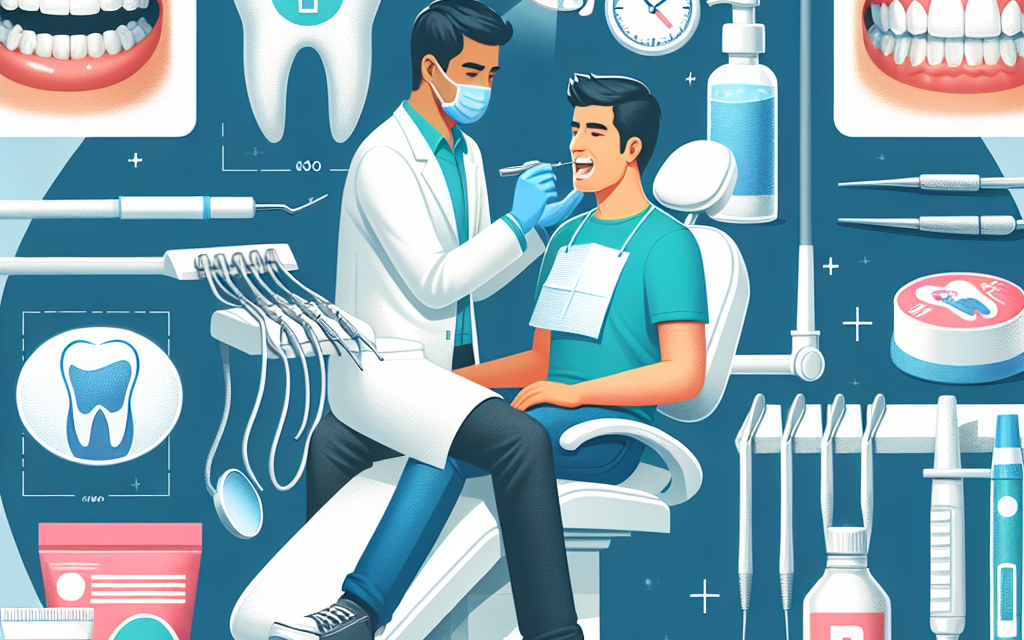Preventing Future Dental Problems Through Restorative Dentistry
Dental health is a crucial aspect of overall well-being, yet many individuals neglect their oral hygiene until problems arise. Restorative dentistry plays a vital role in not only addressing existing dental issues but also in preventing future complications. This article delves into the various facets of restorative dentistry, exploring how it can help maintain optimal dental health and prevent future problems.
Understanding Restorative Dentistry
Restorative dentistry encompasses a range of procedures aimed at restoring the function and aesthetics of teeth that have been damaged or lost due to decay, trauma, or other dental issues. The primary goal is to restore the natural form and function of the teeth, thereby enhancing the patient’s quality of life.
Key components of restorative dentistry include:
- Fillings: Used to treat cavities and restore the shape of the tooth.
- Crowns: Caps placed over damaged teeth to restore their shape, size, and strength.
- Bridges: Fixed prosthetics that replace one or more missing teeth.
- Implants: Artificial tooth roots placed in the jawbone to support replacement teeth.
- Dentures: Removable replacements for missing teeth.
By understanding the various procedures involved in restorative dentistry, patients can make informed decisions about their dental care and take proactive steps to prevent future problems.
The Importance of Early Intervention
One of the most significant advantages of restorative dentistry is the emphasis on early intervention. Many dental problems, such as cavities and gum disease, can be effectively treated if caught early. Delaying treatment can lead to more severe issues, including tooth loss and systemic health problems.
Statistics show that:
- Approximately 92% of adults aged 20 to 64 have had cavities in their permanent teeth.
- Gum disease affects nearly half of adults aged 30 and older.
- Tooth loss is prevalent, with about 178 million Americans missing at least one tooth.
Early intervention through restorative dentistry can significantly reduce the risk of these issues escalating. For example, a simple filling can prevent a cavity from progressing to the point where a root canal or extraction is necessary. Regular dental check-ups and cleanings are essential for identifying potential problems before they become severe.
Common Restorative Procedures and Their Preventive Benefits
Restorative dentistry includes various procedures, each with its unique benefits in preventing future dental problems. Understanding these procedures can help patients appreciate their importance in maintaining oral health.
Fillings
Fillings are one of the most common restorative procedures. When a dentist identifies a cavity, they remove the decayed portion of the tooth and fill it with a material such as composite resin, amalgam, or glass ionomer. This not only restores the tooth’s structure but also prevents further decay.
Benefits of fillings include:
- Preventing Further Decay: By sealing off the cavity, fillings prevent bacteria from entering and causing additional damage.
- Restoring Function: Fillings restore the tooth’s ability to chew and speak properly.
- Aesthetic Improvement: Composite fillings can match the color of natural teeth, enhancing appearance.
Crowns
Crowns are used when a tooth is severely damaged or decayed. They cover the entire tooth, providing strength and protection. Crowns can be made from various materials, including porcelain, metal, or a combination of both.
Benefits of crowns include:
- Protection: Crowns protect weak or damaged teeth from further harm.
- Longevity: With proper care, crowns can last many years, reducing the need for future restorative work.
- Improved Aesthetics: Crowns can enhance the appearance of discolored or misshapen teeth.
Bridges
Bridges are used to replace one or more missing teeth by anchoring to adjacent teeth. This not only restores the smile but also prevents the remaining teeth from shifting out of position.
Benefits of bridges include:
- Restoration of Function: Bridges allow for normal chewing and speaking.
- Prevention of Tooth Movement: By filling the gap left by missing teeth, bridges prevent adjacent teeth from drifting.
- Aesthetic Enhancement: Bridges can improve the overall appearance of the smile.
Implants
Dental implants are a more permanent solution for missing teeth. They involve placing a titanium post into the jawbone, which serves as a root for a replacement tooth. Implants are known for their durability and natural appearance.
Benefits of implants include:
- Bone Preservation: Implants stimulate the jawbone, preventing bone loss that often occurs with missing teeth.
- Longevity: With proper care, implants can last a lifetime, reducing the need for future dental work.
- Natural Appearance: Implants look and function like natural teeth, enhancing confidence.
Dentures
Dentures are removable appliances that replace missing teeth. They can be complete (replacing all teeth) or partial (replacing some teeth). Modern dentures are designed to be comfortable and natural-looking.
Benefits of dentures include:
- Restoration of Function: Dentures allow individuals to eat and speak normally.
- Improved Aesthetics: Dentures can enhance facial appearance by providing support to the lips and cheeks.
- Cost-Effective Solution: Dentures are often more affordable than implants or bridges.
The Role of Preventive Care in Restorative Dentistry
Preventive care is an integral part of restorative dentistry. Regular dental visits, cleanings, and patient education can significantly reduce the risk of dental problems. Here are some key aspects of preventive care:
Regular Check-Ups
Regular dental check-ups are essential for maintaining oral health. During these visits, dentists can identify early signs of decay, gum disease, and other issues. Early detection allows for timely intervention, which can prevent more extensive restorative work in the future.
Professional Cleanings
Professional cleanings remove plaque and tartar buildup that regular brushing and flossing may miss. This helps prevent cavities and gum disease, reducing the need for restorative procedures.
Patient Education
Educating patients about proper oral hygiene practices is crucial. Dentists can provide guidance on effective brushing and flossing techniques, dietary choices, and the importance of avoiding tobacco products. Knowledge empowers patients to take control of their dental health.
Fluoride Treatments
Fluoride treatments can strengthen tooth enamel and make it more resistant to decay. Dentists may recommend fluoride varnishes or gels, especially for children and individuals at higher risk for cavities.
Sealants
Dental sealants are thin coatings applied to the chewing surfaces of back teeth. They create a barrier against bacteria and food particles, significantly reducing the risk of cavities. Sealants are particularly beneficial for children and adolescents.
Case Studies: Success Stories in Restorative Dentistry
Real-life examples can illustrate the effectiveness of restorative dentistry in preventing future dental problems. Here are a few case studies that highlight successful outcomes:
Case Study 1: Early Intervention with Fillings
A 30-year-old patient visited the dentist for a routine check-up. X-rays revealed early-stage cavities in two molars. The dentist recommended fillings to prevent further decay. The patient followed through with the treatment, and after a few years, the fillings remained intact, preventing the need for more invasive procedures like root canals.
Case Study 2: The Impact of Crowns
A 45-year-old woman experienced significant wear on her teeth due to grinding. After a thorough examination, the dentist recommended crowns for her most damaged teeth. The crowns restored her bite and prevented further wear, allowing her to maintain her natural teeth for years without additional restorative work.
Case Study 3: Successful Implant Placement
A 50-year-old man lost a tooth due to an accident. He opted for a dental implant instead of a bridge. The implant was placed successfully, and over time, it integrated with the jawbone. The patient reported improved confidence and function, and he has not experienced any complications since the procedure.
Case Study 4: The Benefits of Dentures
An 80-year-old woman had lost most of her teeth due to decay and gum disease. She chose to get dentures, which significantly improved her quality of life. She could eat a wider variety of foods and felt more confident in social situations. Regular follow-ups ensured her dentures fit well and remained comfortable.
Case Study 5: Preventive Care Success
A 25-year-old man had a history of cavities. After a comprehensive dental evaluation, his dentist implemented a preventive care plan that included regular check-ups, professional cleanings, and fluoride treatments. Over the next five years, he experienced no new cavities, demonstrating the effectiveness of preventive care in restorative dentistry.
Conclusion: The Path to a Healthier Smile
Restorative dentistry is a powerful tool in preventing future dental problems. By understanding the various procedures available and the importance of early intervention, patients can take proactive steps to maintain their oral health. Regular check-ups, professional cleanings, and patient education are essential components of a successful preventive care strategy.
Through case studies and real-life examples, it is evident that restorative dentistry not only addresses existing issues but also plays a crucial role in preventing future complications. By investing in restorative care and prioritizing preventive measures, individuals can enjoy healthier smiles and improved quality of life for years to come.
In summary, restorative dentistry is not just about fixing problems; it is about creating a foundation for long-term dental health. By embracing restorative practices and preventive care, patients can ensure that their smiles remain bright and healthy for a lifetime.





